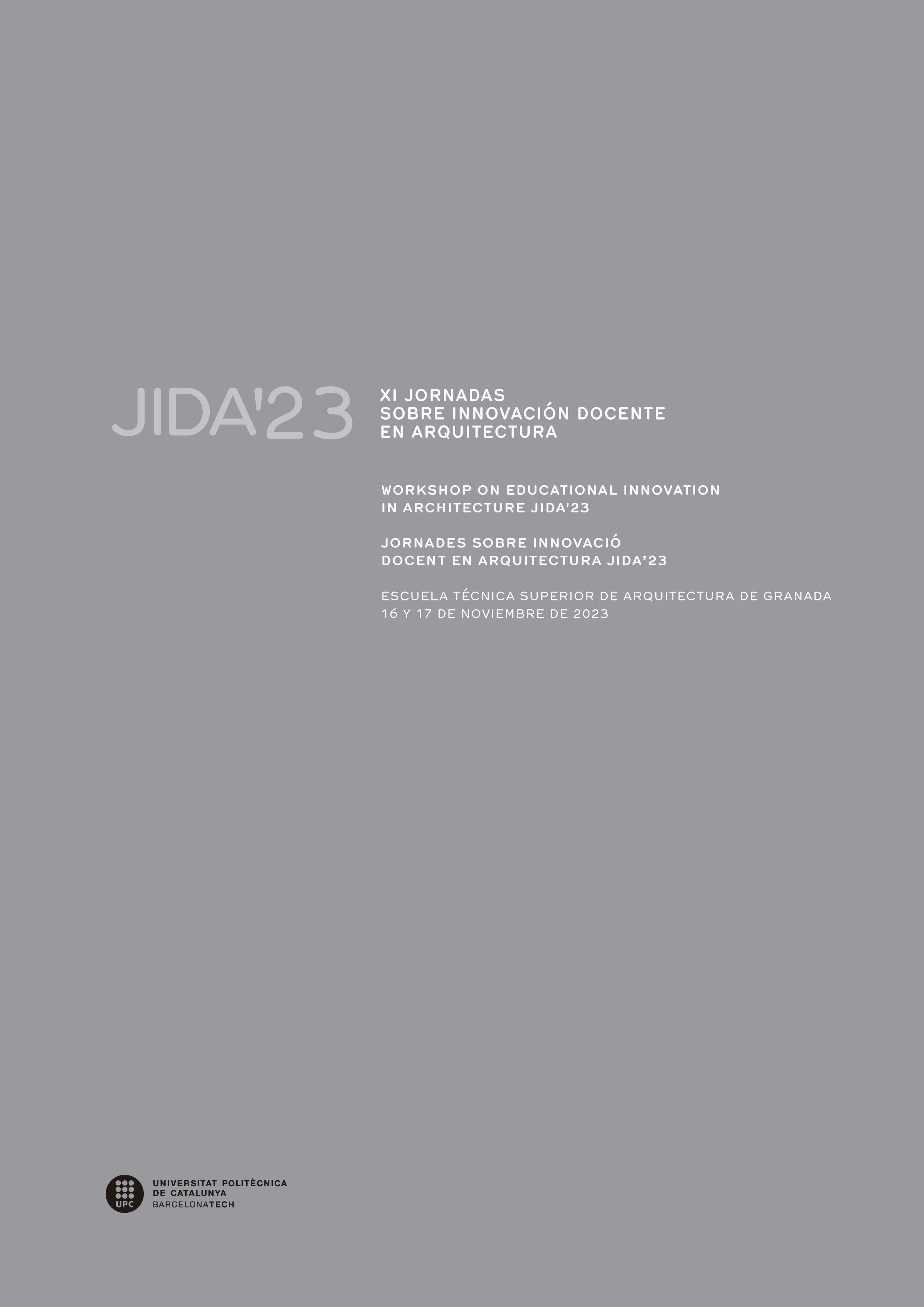Landscape resonance: natural-artificial reciprocities learnt from architecture
DOI:
https://doi.org/10.5821/jida.2023.12302Keywords:
landscape design, bioprocess, resonance, Osgood technique, responsive architectureAbstract
Design with a resounding way of being in the world through a Design Unit at the University of Alicante that anchors its exercises at the hinterland that surrounds our cities; try to evaluable and compare it. These are the main goals of the learning process that this paper explains. To do this, the Design Unit works from how a Buddhist community understand the landscape; from lessons about the animist and the vibrant; and from lessons on kinetic architecture. The Osgood technique is used so that the students make their own assessment of the experience. The system works as a questionnaire on concepts (theoretical dimensions, transversal competencies, scope of the method) in which to choose a suitable position from 1 to 7. Three of the concepts are selected to generate a visual model at the digital representational space Rhinoceros that allows a certain emphasis or discourse about the results.
References
Abbott, Mick; y Bowring, Jacky. 2020. “the Design Lab approach to teaching landscape”. En The Routledge Handbook of Teaching Landscape, editado por Jorgensen, Karadeniz, Mertens y Stiles, 291-299. New York: Routledge.
Armstrong, Rachel. 2015. Vibrant Architecture. Matter as a codesigner of living structures. Berlin: De Gruyter.
Armstrong, Rachel. 2018. Soft Living Architecture. An Alternative View of Bio-informed Practice. London: Bloomsbury.
Beesley, Philip. 2016. “Dissipative Models: Notes towards Design Method”. En Living Architecture Systems Group Symposium. White Papers, editado por Philip Beesley y Ala Roushan, 6-17. Waterloo: Riverside Architectural Press.
Bennett, Jane. 2018. “Vibrant matter”. En Posthuman Glossary, editado por Braidotti y Hlavajova, 447. London: Bloomsbury.
Bennett, Jane. 2022. Materia vibrante. Una ecología política de las cosas. Buenos Aires: Caja Negra Editora.
Carrasco, Jose; González, Sandra. 2015. Ori-ssors: research processes in between vegetal crease patterns, expandable scissors and miura-ori solutions. IASS Symposium on Future Visions. Amsterdam. http://hdl.handle.net/10045/7.
Desselle, S. 2005. “Construction, Implementation and Analysis of Summated Rating Attitude Scales”. American Journal of Pharmaceutical Education, 69 (5), 1-11.
Fernández, Alberto; Ortega, Susana. 2018. Coastal Fog Tower. Design and Fabrication Process of a vertical fog capture device. SIGRADI. Sao Carlos, Brasil.
Gisbert Alemany, Ester. 2016. An Architecture by means of Anthropology. Beyond learning the tools of social science. Revista i2, 4 (1). doi: 10.14198/i2.2016.4.05.
Gustavsson, Roland; Gunnarsson, Allan y Wistrom, Bjorn. 2020. “Time out! Thirty years of experiences from outdoor landscape teaching”. En The Routledge Handbook of Teaching Landscape, editado por Jorgensen, Karadeniz, Mertens y Stiles, 135-147. New York: Routledge.
Lulham, R., y Shank, D. 2015. “An affective Tool to Asssist in Designing Innovations”. IASDR, En Interplay, 1371-1379.
Olwig, Kenneth R. 2008. “Performing on the Landscape versus Doing Landscape: preambulatory Practice, Sight and the Sense of Belonging”. En Ways of Walking. Ethnography and Practice on Foot, editado por Ingold y Vergunst. Surrey: Ashgate.
Ingold, Tim. 2013. Making. Anthropology, Archaeology, Art and Architecture. London and New York: Routledge.
Lyon, Dawn. 2019. What is rhythmanalysis? London: Bloomsbury Academic.
Rosa, Hartmut. 2019. Resonancia. Una sociología de la relación con el mundo. Buenos Aires: Katz conocimiento.
Rosa, Hartmut. 2020. Lo indisponible. Barcelona: Herder.
Saunders, Andrew. 2016. “Robotic Lattice Smock”. En Robotic Fabrication in Architecture, Art and Design editado por Reinhardt, Saunders y Burry. 78-91. Springer Cham.
Serrano, Salvador; Carrasco, Jose; Morales, Francesc, Gutiérrez, Juan Pablo. 2018. Cooperative Trees by Adding Inosculated and Discrete Definitions to a DLA Design. Actas del congreso eCAADe 36. doi: 10.52842/conf.ecaade.2018.2.103.



















